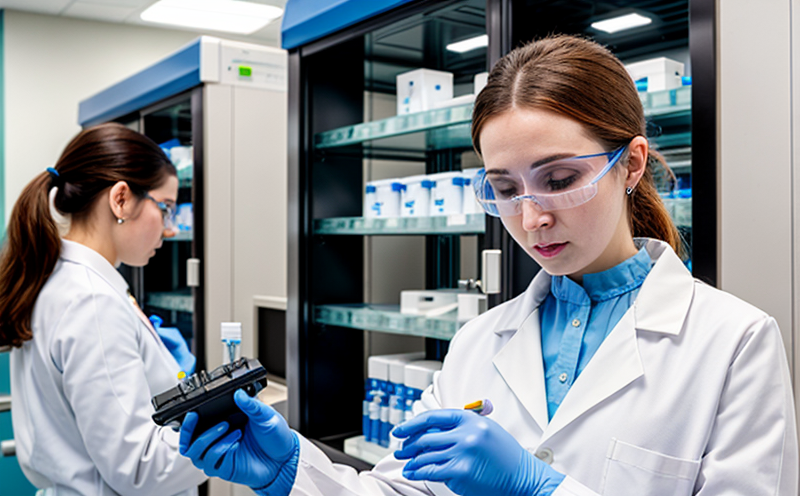Solid Phase Extraction Bioanalysis Testing
In the pharmaceutical sector, bioanalytical testing is critical to ensure drug safety and efficacy. Solid Phase Extraction (SPE) bioanalysis plays a pivotal role in this process by providing accurate quantification of small molecule drugs, metabolites, and biomarkers in biological matrices such as plasma, serum, urine, and saliva. This technique leverages the selective adsorption properties of solid sorbents to isolate analytes from complex mixtures.
Pharmaceutical testing laboratories specializing in bioanalytical services utilize SPE for several reasons. The method is highly sensitive, enabling detection at trace levels, which is essential for quantifying drug concentrations during clinical trials and post-marketing surveillance. SPE also enhances the specificity of analytical methods by reducing matrix effects that could interfere with accurate measurement.
The process typically involves multiple steps: sample collection, preparation, conditioning, equilibration, loading, washing, elution, and analysis. Each step is meticulously controlled to ensure reproducibility and precision. For instance, the choice of sorbent material (C18, silica, etc.) depends on the analyte properties and matrix composition.
Instrumentation used in SPE bioanalysis includes vacuum pumps or autosamplers for automation, analytical balance for precise weighing, and high-performance liquid chromatography (HPLC) coupled with mass spectrometry (MS) for final quantification. The use of MS enhances the sensitivity and selectivity of the analysis.
Acceptance criteria for SPE bioanalysis testing are stringent to ensure reliable results. These include linearity over a wide range, accuracy within ±10%, precision with
Real-world applications of SPE bioanalysis in the pharmaceutical industry include drug development, where it helps identify optimal dosing regimens; quality assurance, ensuring product consistency; and regulatory compliance, meeting stringent FDA and EMA guidelines. For R&D engineers, this testing ensures that new drug candidates undergo rigorous evaluation before entering clinical trials.
Pharmaceutical companies rely on laboratories with expertise in bioanalytical testing to provide robust data for decision-making processes. The integration of SPE into their protocols is key to achieving these goals, making it an indispensable tool in the pharmaceutical sector.
Scope and Methodology
| Parameter | Description |
|---|---|
| Sorbent Selection | The choice of sorbent depends on the analyte properties. C18 is often used for polar compounds, while silica works well with non-polar substances. |
| Sample Preparation | Involves dilution and conditioning to ensure optimal performance during loading. |
| Loading | Analyte retention on the sorbent surface is achieved through adsorption forces. |
| Washing | This step removes non-target compounds, improving selectivity. |
| Elution | The analyte is selectively released from the sorbent using appropriate solvents. |
| Analysis | HPLC-MS/MS is used for final quantification and identification of analytes. |
The methodology ensures that all steps are optimized to achieve accurate results. Each step must be carefully controlled, with specific conditions defined in the protocol. The use of validated methods and standardized procedures guarantees consistent performance across different batches of samples.
Industry Applications
| Application | Description |
|---|---|
| Pharmacokinetics | SPE bioanalysis helps in determining the absorption, distribution, metabolism, and excretion of drugs. |
| Therapeutic Drug Monitoring | Evaluates drug levels to ensure safe dosing for individual patients. |
| Toxicology Studies | Identifies toxic compounds that may interfere with drug efficacy or safety. |
| Clinical Trials | Supports the development of new drugs by providing critical data on pharmacokinetics and metabolism. |
| Post-Marketing Surveillance | Monitors drug performance in a real-world setting to identify any potential issues. |
| Bioequivalence Studies | Compares the bioavailability of different formulations or generics. |
| Pharmacogenomics | Studies how genetic variations affect drug response and metabolism. |
The versatility of SPE bioanalysis makes it an essential tool across various stages of pharmaceutical development. Its ability to handle complex biological samples with high specificity and sensitivity is crucial for meeting the stringent requirements of regulatory bodies worldwide.
Quality and Reliability Assurance
Ensuring the quality and reliability of SPE bioanalysis testing is paramount in the pharmaceutical industry. Laboratories adhere strictly to international standards such as ISO 17025, which governs the competence of inspection bodies. This ensures that all tests are conducted under controlled conditions with accurate instrumentation.
Quality control measures include regular calibration of instruments, validation of methods, and participation in proficiency testing programs. These steps ensure that every test is reproducible and meets regulatory requirements. Compliance officers rely on these data to maintain the integrity of their product development processes.
The reliability of SPE bioanalysis is further enhanced by the use of standardized protocols and trained personnel. Rigorous training ensures that operators understand the nuances of each step in the process, from sample preparation to final analysis. This expertise is critical for interpreting results accurately and making informed decisions based on the data generated.
Pharmaceutical companies trust laboratories with a proven track record of quality and reliability. By investing in cutting-edge technology and skilled personnel, these labs ensure that their services meet the highest standards of accuracy and precision. The result is robust data that can be trusted for regulatory submissions and internal decision-making.





